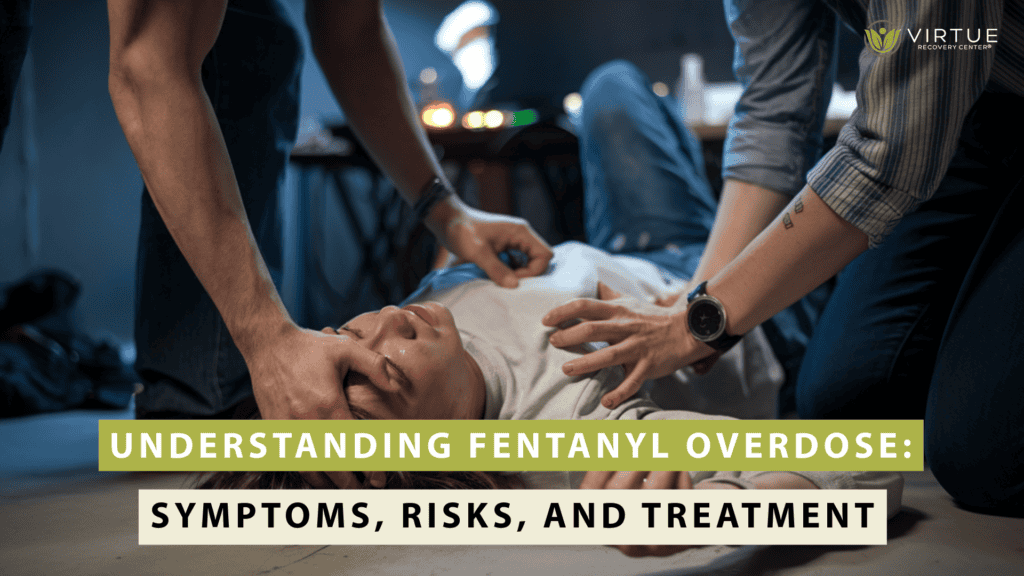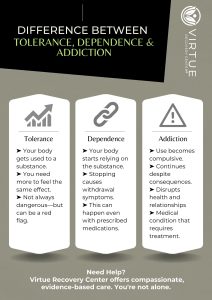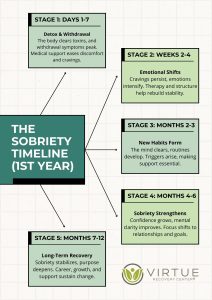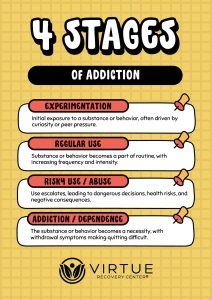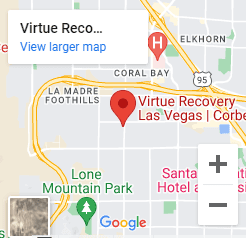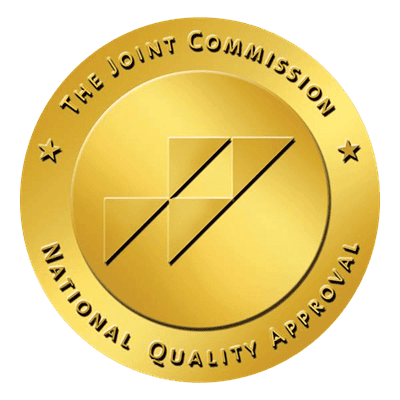Fentanyl overdose can be identified easily and can be a lifesaver. This article describes the signs of an overdose, the dangers, and what to do in the first moments of an overdose. Understand how to manage an overdose and how to avoid one from happening.
Key Takeaways
- Fentanyl, a highly potent synthetic opioid, poses severe overdose risks, with symptoms manifesting rapidly and significantly differing from other opioids.
- Immediate actions during a fentanyl overdose, such as calling 911 and administering naloxone, are crucial for survival; certain harmful actions should be strictly avoided.
- Prevention strategies include access to naloxone, fentanyl test strips for drug testing, and awareness of mixing substances to reduce overdose risks.
What are Fentanyl and Other Synthetic Opioids?

Fentanyl is a synthetic opioid analgesic that is used in medicine for pain management and anesthesia. It is extremely powerful, being fifty times more potent than heroin and a hundred times more potent than morphine. This high efficacy makes it one of the strongest synthetic opioids on the market, which can be used to relieve pain effectively, but at the same time, it has a high chance of causing harm if used in the wrong way.
Fentanyl can be ingested in different ways, such as powders, pills, patches, and liquids. This flexibility in administration is one of the reasons for its misuse and the possibility of fatal overdoses with fentanyl and other synthetic opioids.
From being used as a painkiller to being sold in the black market, fentanyl has become a major concern in America as it has contributed to the increase in opioid overdose and the abuse of prescription medication.
Recognizing a Fentanyl Overdose

Knowing the signs of a fentanyl overdose can save a life. Symptoms are severe and include constricted pupils, respiratory depression, cold and clammy skin, cyanosis, respiratory arrest, reduced level of consciousness, and unresponsiveness. Anyone who is suspected of having an overdose should be taken to the hospital as soon as possible.
A fentanyl overdose necessitates immediate action due to its rapid onset of symptoms. Monitoring breathing is critical, as the effects can persist. Recognizing these signs quickly can prompt urgent medical help.
Common Overdose Symptoms and Signs
The common signs and symptoms of a fentanyl overdose are stark and alarming. Patients may exhibit:
- very small, pinpoint pupils
- slow or shallow breathing
- gurgling noises
- cold clammy skin
- blue or purple lips and nails
- a limp body
- a slow or weak pulse
Stupor and changes in the size of the pupils are also signs of an overdose of fentanyl. Identifying these symptoms early is important so the patient can be taken to the hospital and possibly be saved. The severity of the problem shows that one should at least know what to look for.
How Fentanyl Overdose Differs from Other Opioid Overdoses
Fentanyl overdose is not different from other opioid overdoses except that fentanyl is highly potent. Symptoms appear more quickly and are usually more pronounced. The quick onset means there is a need to ensure early identification and management of the situation.
Some of the signs of a fentanyl overdose include; blue or purple discoloration of the lips and nails. These symptoms are more severe because fentanyl is a potent drug that causes rapid and severe respiratory depression than other opioids.
Recognizing these differences aids in faster identification and drug treatment.
Risk Factors for Fentanyl Overdose
Several factors can increase the chances of a fentanyl overdose. People with opioid use disorder are at a higher risk because they have a higher tolerance and the risk of abusing the medication. Combining substances, particularly depressants such as alcohol, with fentanyl leads to an increased risk of the effects of the substances.
Heroin use, which can be mixed with fentanyl, increases the chances of an overdose because the strength of the drug is often not consistent. Using prescription opioids that a doctor does not prescribe can cause abuse and raise the chances of fentanyl overdose. Knowing these risk factors can prevent a deadly overdose from occurring.
The presence of all these factors makes it very risky for even a small amount of fentanyl to be ingested. Knowledge and information on these risks can assist people in preventing such occurrences and possibly prevent deaths.
Immediate Actions During a Fentanyl Overdose
In the event of a suspected fentanyl overdose, immediate action is crucial in a medical emergency.
The first step is to:
- Call 911 as soon as possible to ensure immediate medical intervention.
- If naloxone is available, administer it as it can reverse the life-threatening effects of a fentanyl overdose.
- Monitor the person’s breathing and turn them on their side to maintain an open airway.
Good Samaritan laws encourage individuals to seek emergency help without fear of legal repercussions, providing legal protection for those who assist in an overdose emergency.
Using Naloxone
Naloxone is the only medication that can reverse the effects of opioid poisoning or an opioid overdose and is available under the brand names Narcan® and Kloxxado®. It is an opioid antagonist that reverses the effects of opioids and returns normal respiration within a few minutes. Naloxone is available in different forms, such as injections and nasal sprays, thus easily administered in cases of an overdose.
Naloxone, which can be obtained over the counter from a pharmacy or community health organization, is essential. It should be given, and the patients should be observed in a hospital for at least two hours because the drug’s impact is between half an hour and one and a half hours.
What Not to Do
During a fentanyl overdose, certain actions can be harmful and should be avoided. Here are some examples of what NOT to do:
- Putting the person in a cold shower can shock or worsen their condition.
- Attempting to wake them by slapping or hitting can cause unnecessary harm and is ineffective.
- Inducing vomiting, which is dangerous and not recommended in an overdose situation.
Do not leave the overdosed person alone; immediate medical attention is critical. Knowing these “don’ts” is as important as knowing the steps to take.
Treatment Options After a Fentanyl Overdose

Surviving a fentanyl overdose is just the first step; follow-up treatments are essential for long-term recovery. Medication-assisted treatment (MAT) is effective and should ideally be started in a hospital setting rather than waiting for outpatient services. This approach combines medications with counseling and behavioral therapies to treat substance use disorders.
It is important to ensure that drug recovery support services are culturally appropriate for individuals from different cultural backgrounds so that they can recover in the long run. These comprehensive treatment options are important in avoiding future overdoses and ensuring that the patient can maintain long-term recovery.
Many who had a non-fatal overdose are still prescribed opioids, and this raises the chances of another overdose. It’s necessary to undergo inpatient or outpatient therapy to deal with the root cause of substance abuse to avoid relapse. Recovery is difficult but not impossible; someone can get better with the right care and treatment.
Prevention Strategies
To reduce fentanyl overdoses, a combination of measures must be taken. The availability of naloxone is crucial for the patients and their families and friends. Having naloxone at home and having it with you can be a lifesaver in the event of an overdose. Fentanyl test strips are cheap tools used to determine the presence of fentanyl in different substances to help prevent overdose.
A credible method of testing drugs for fentanyl gives people a way to reduce their chances of overdosing since they are aware of the substances they are taking. Fentanyl test strips can identify the presence of the drug in a small amount of a substance, which is very helpful in the process of harm reduction.
Not taking more than one drug at a time, for instance, not taking stimulants such as methamphetamine, together with depressants such as alcohol, can greatly minimize the chances of an overdose. Other important measures include being careful with the medicines that one takes and avoiding substances that cause drowsiness. It is always better to prevent than to cure, and these measures may go a long way in preventing deaths. Also, the use of several drugs at the same time may lead to the development of side effects.
Legal Protections and Good Samaritan Laws
Good Samaritan laws are meant to protect people who call for help in case of an overdose from arrest. These laws provide legal protection from arrest or prosecution for drug possession to those who seek help in case of an overdose. The details of these laws may vary across states; some allow for protection against parole violations and minor warrant arrests.
Mississippi has a Good Samaritan law that shields individuals who call in case of an overdose for themselves or another person. Understanding these legal protections can help reduce anxiety and prompt immediate action, which may be lifesaving.
What Are the Risks of Fentanyl Overdose Compared to Heroin Overdose?
Fentanyl overdose poses a higher risk compared to heroin overdose due to its potency. Fentanyl is 50-100 times more potent than heroin, increasing the likelihood of an overdose. Those struggling with addiction should discover interesting facts about heroin addiction and abuse to understand the dangers and seek help.
Statistics on Fentanyl Overdose
The statistics on fentanyl overdose show how acute this public health issue is. Monthly updates are provided for provisional counts of drug overdose deaths. This update is based on the death records processed by the National Center for Health Statistics (NCHS). The WHO has recommended ways of coding and classifying causes of death to ensure that drug-related deaths are well understood. In 2023, law enforcement agencies confiscated more than 115 million pills of fentanyl that is illicit.
Although drug use among adolescents in 2023 was low, opioid-involved overdose deaths among teenagers increased. About 57% of the fatal overdoses involved fentanyl, and 90% of them had other drugs in their system, such as cocaine, meth, or heroin. These shocking statistics highlight the importance of prevention and intervention measures to address drug abuse.
The provisional figures could be lower than the real drug overdose deaths because some cases are still under investigation, and some death records are not yet submitted. This data supports the fact that the fentanyl overdose epidemic remains a persistent problem and that there is no room for complacency.
Getting Help for Addiction
If you or someone you know might be addicted to fentanyl, a drug rehab center can help. Addiction is a disease that can be managed and managed with the right help and intervention.
Virtue Recovery Center provides a full range of services designed to meet the patient’s specific requirements and help him or her start the recovery process. Please do not hesitate to contact our admissions navigators for information on the most suitable treatment program and to begin the process of positive change in your life or the life of your loved one.
Conclusion
It is important to know about fentanyl overdose to prevent deaths. Knowing the signs of an overdose and what to do in the first moments can be very helpful in saving a life. Understanding the factors that increase the risk of an overdose and the measures that can be taken to prevent it can be life-saving. Legal measures such as the Good Samaritan laws ensure people are not afraid to intervene at the right time.
The statistics on fentanyl overdose show the severity of this problem and the importance of further work for prevention and treatment. By being aware of the problem and being ready for it, we can help to minimize the effects of fentanyl overdoses. Together we can combat this crisis and prevent further loss of lives.
Frequently Asked Questions
Q: What immediate actions should be taken if someone is experiencing a fentanyl overdose?
A: If someone is experiencing a fentanyl overdose, call 911 immediately, administer naloxone if you have it, monitor their breathing, and position them on their side.
Q: What should you not do if someone is overdosing?
A: You should never attempt to wake an overdosing person by slapping them, forcing liquids, or making them vomit. Instead, call emergency services immediately and stay with them until help arrives.
Q: How much stronger is fentanyl compared to heroin and morphine?
A: Fentanyl is incredibly potent, being up to 50 times stronger than heroin and up to 100 times stronger than morphine. This stark difference highlights the serious risks associated with its use.
Q: What are some risk factors for a fentanyl overdose?
A: Be vigilant about these risk factors for a fentanyl overdose: using heroin, taking non-prescribed prescription opioids, mixing fentanyl with other drugs, and having an opioid use disorder.
Q: How can you help prevent a fentanyl overdose?
A: To prevent a fentanyl overdose, be aware of the signs, keep a naloxone rescue kit readily available, and avoid mixing substances that can enhance sedation. Taking these precautions can save lives.
Resources
UC Davis Health Blog: “Fentanyl facts, overdose signs to look for, and how you can help save a life”
https://health.ucdavis.edu
National Institute on Drug Abuse (NIDA): “What is fentanyl?”
Nida.nih.gov
SAMHSA: “SAMHSA Overdose Prevention and Response”
SAMHSA.gov

